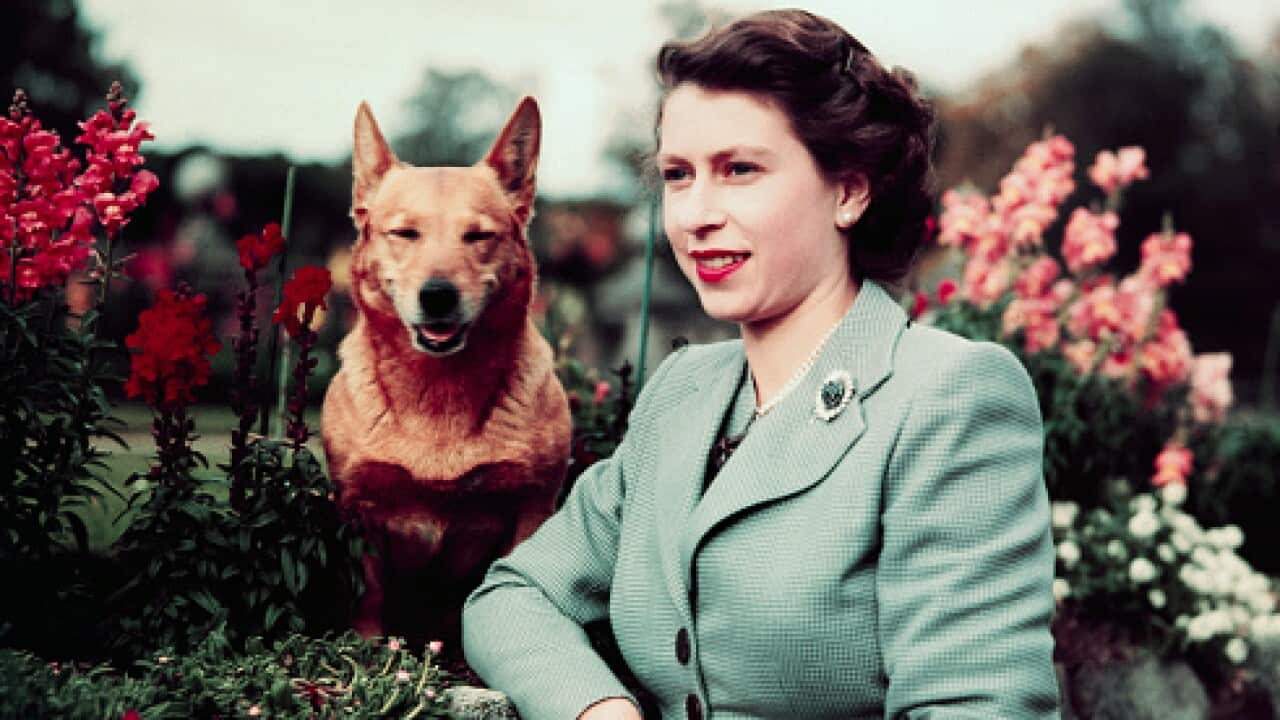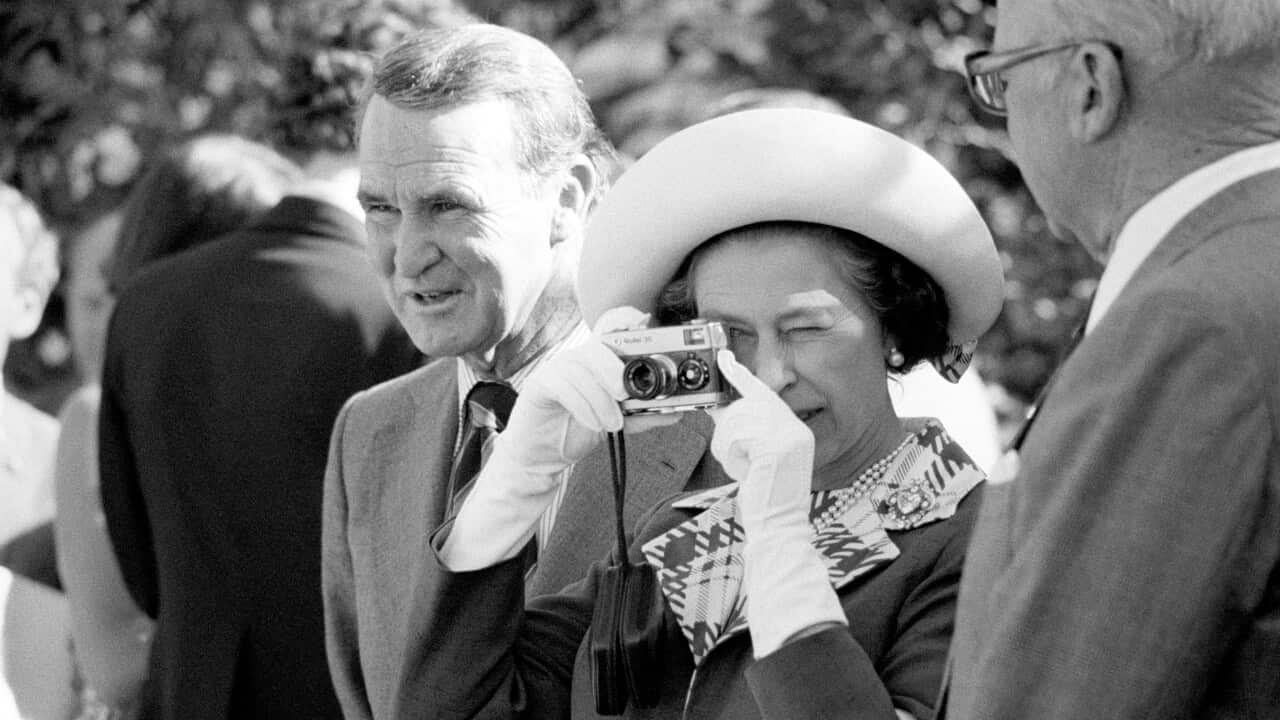

6 min read
This article is more than 2 years old
Obituary
Elizabeth II: The accidental queen who seemed born to rule
Her ascent to the throne was sudden and unexpected, but Queen Elizabeth II, who has died aged 96, took to the role with an overriding sense of duty, becoming the longest-reigning monarch in British history.
Published 9 September 2022 5:45am
Source: SBS News
Image: Queen Elizabeth at Balmoral Castle with one of her corgis in 1952. (SBS News / Bettmann/Bettmann Archive)
Key Points
- Her ascent to the throne was sudden and unexpected.
- Queen Elizabeth II, who has died aged 96, took to the role with an overriding sense of duty.
Elizabeth Alexandra Mary Windsor was never meant to be Queen, but even in the early days of her reign, it seemed she was fulfilling a destiny.
Born on 26 April 1926, a series of tumultuous events would set her on the path to the throne, but none of that seemed on the horizon as she first stepped into public life as a teenager during World War II.
She served in the Auxiliary Territorial Service and trained as a truck driver and mechanic.

Princess Elizabeth driving an ambulance during her wartime service in the A.T.S. (Auxiliary Territorial Service), 10th April 1945. Credit: Bryn Colton/Getty Images
In 1936, her father, the Duke of York, became King George VI when her uncle King Edward VIII abdicated the throne for love.
As a teenager, Elizabeth had met Prince Philip of Greece and Denmark, and in 1947, after almost a decade of correspondence, the pair married at Westminster Abbey. The princess was 21 and Philip, 25.

Princess Elizabeth and Prince Philip wave from the balcony of Buckingham Palace, London, on their wedding day in 1947. Credit: Keystone/Getty Images
Her father died suddenly in his sleep aged 56 and Princess Elizabeth, at 25, four years older than her sister Margaret, was next in line to the throne.

Elizabeth returns to London from Kenya as Queen on 7 February 1952 following the death of her father King George VI. Credit: Keystone/Getty Images
After months of meticulous preparation, on 2 June 1953, Queen Elizabeth II was crowned at Westminster Abbey.
Much of Britain shared the moment too as it was the first time a coronation was televised.

Queen Elizabeth II during her coronation at Westminster Abbey in 1953. Credit: Hulton Archive/Getty Images
She was the first reigning British monarch to visit Australia in what was the first of 16 visits to this country.
An estimated three-quarters of Australia's population of almost nine million people turned out to see her.

Britain's Queen Elizabeth II and Prince Philip drive past cheering crowds on Sydney's George St in 1954. Source: AP / AP
If she wasn't travelling she was hosting world leaders at Buckingham Palace, including at extravagant state banquets.

Baby Prince Andrew perches on Prince Philip's lap during a picnic on the grounds of Balmoral Castle. Also pictured are Queen Elizabeth, Prince Charles, and Princess Anne. Credit: Bettmann/Bettmann Archive
And the message was all about helping others; the Queen was a patron for more than 600 charities, including military, medical and animal organisations.

The Queen with US President Joe Biden at Windsor Castle in June 2021. Credit: Pool/Samir Hussein/WireImage
I often draw strength from meeting ordinary people doing extraordinary things.Queen Elizabeth II, 2016
During her reign, she awarded thousands of people with honours - from MBEs and knighthoods to the Victoria Cross.
From the annual Trooping the Colour to Royal Ascot, people of all ages embraced the monarchy under Elizabeth's reign, but her popularity was tested in 1997.

The Queen knights 100-year-old Captain Thomas Moore after he raised millions of pounds for health care services during the height of the COVID-19 pandemic. Credit: Pool/Max Mumby/Getty Images
The death of Princess Diana in a car crash in Paris at the age of 36 saw a huge outpouring of grief from the British public. But the Queen was not seen publicly for five days.
Following a public outcry, she made a national address in which she paid tribute to her daughter-in-law.

(left to right) Prince Charles, Prince Harry and Prince William examine floral tributes left outside Kensington Palace following the death of Princess Diana in 1997. Credit: Anwar Hussein/WireImage

Members of the royal family watch the Trooping the Colour parade from the Buckingham Palace balcony in 2017. Credit: James Devaney/WireImage
The Queen was said to be deeply hurt, but Harry made it clear his relationship with his grandmother was strong.
Throughout her life, the Queen’s dedication to her family – and the Commonwealth – was unwavering, even in the difficult early days of the COVID-19 pandemic.
She was forced into isolation with her husband in Windsor Castle but remained in the public eye. A rare TV address - only the fifth of her reign - offered hope.

The Queen with Meghan, Duchess of Sussex, Prince Harry, Duke of Sussex, Prince William Duke of Cambridge and Catherine, Duchess of Cambridge in 2018. Source: Getty / WPA Pool
"I hope in the years to come everyone will be able to take pride in how they responded to this challenge. And those who come after us will say the Britons of this generation were as strong as any."
As Britain’s pandemic death toll soared, the monarch experienced a profound personal loss with her husband of 73 years dying two months before his 100th birthday in April 2021.
COVID-19 restrictions meant Prince Philip's funeral was as he wanted it; without too much pomp or ceremony.

Queen Elizabeth at the funeral of her husband, Prince Philip, at St George's Chapel, Windsor Castle, on 17 April 2021. Credit: WPA Pool/Getty Images
She soon returned to work, with video calls from Windsor Castle, and before long she was back meeting world leaders.

Queen Elizabeth II with then Australian Prime Minister Scott Morrison at Windsor Castle in June 2021. Credit: Steve Parsons/PA
"Of course, the benefits of such actions will not be there to enjoy for all of us here today: none of us will live forever,” she said. "But we are doing this not for ourselves but for our children and our children's children, and those who will follow in their footsteps.”

The Queen delivers a video message to the COP climate conference in Glasgow in November, 2021. Ill health prevented her from attending in person. Credit: Handout/Buckingham Palace via Getty Imag
In 2022, Queen Elizabeth celebrated her Platinum Jubilee - 70 years on the throne. She was the longest-reigning British monarch, surpassing the 63-year reign of her great-great-grandmother Queen Victoria.
But in May she withdrew from the State Opening of Parliament and the reading of the Queen's speech because of "episodic mobility problems." It's the first time since 1963 she has not attended the event.
The Queen handed her duties at the opening to Prince Charles and Prince William, with Charles reading her speech and Charles and William jointly opening parliament.

Queen Elizabeth II on 2 June 2022 in London. Source: Getty / WPA Pool/Getty Images
In a statement early Friday morning Australian time, Buckingham Palace confirmed: She was 96.
Her eldest son Charles, now 73, automatically becomes king of the United Kingdom and the head of state of 14 other realms including Australia, Canada and New Zealand. He will be known as Charles III.

